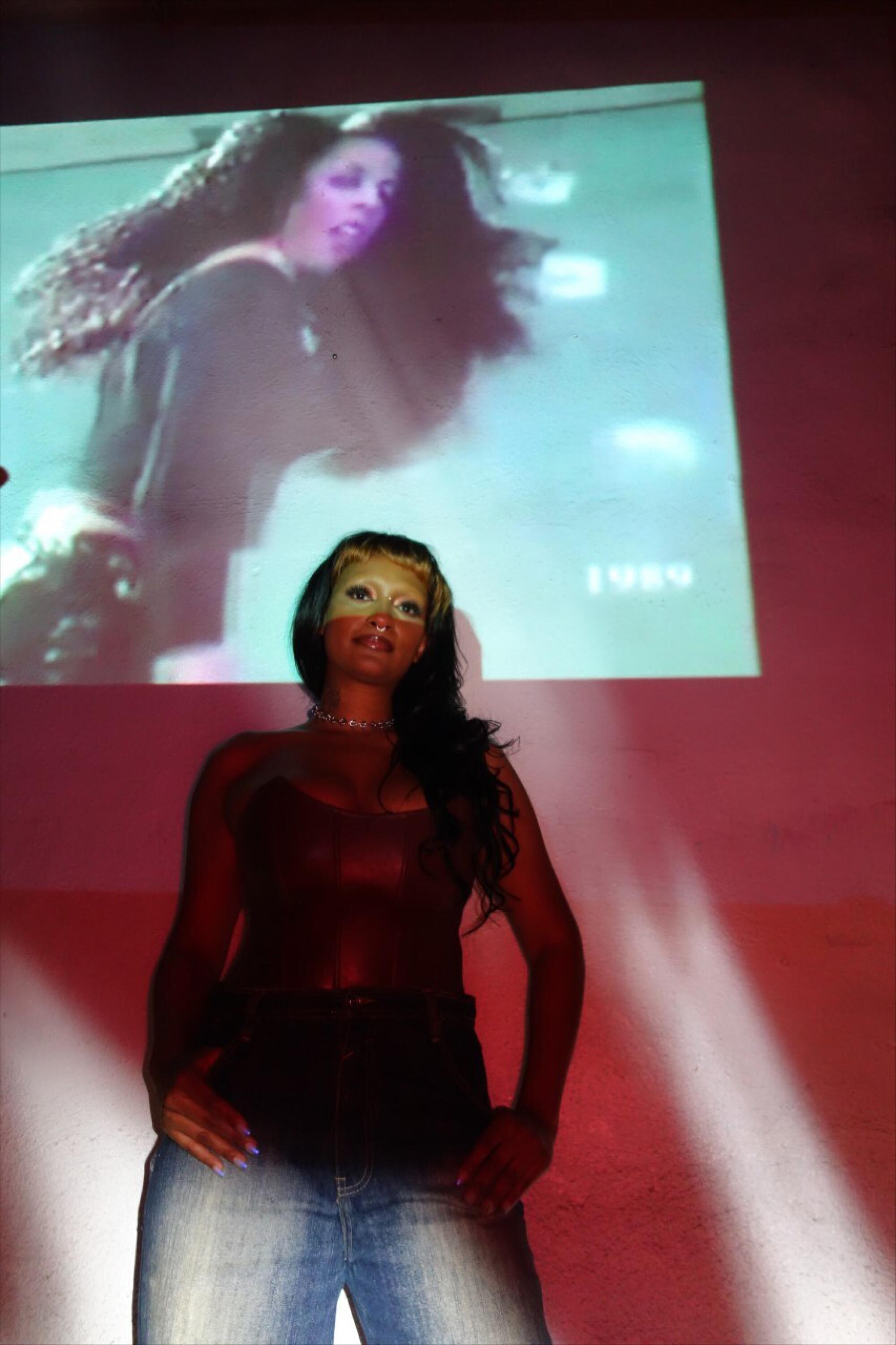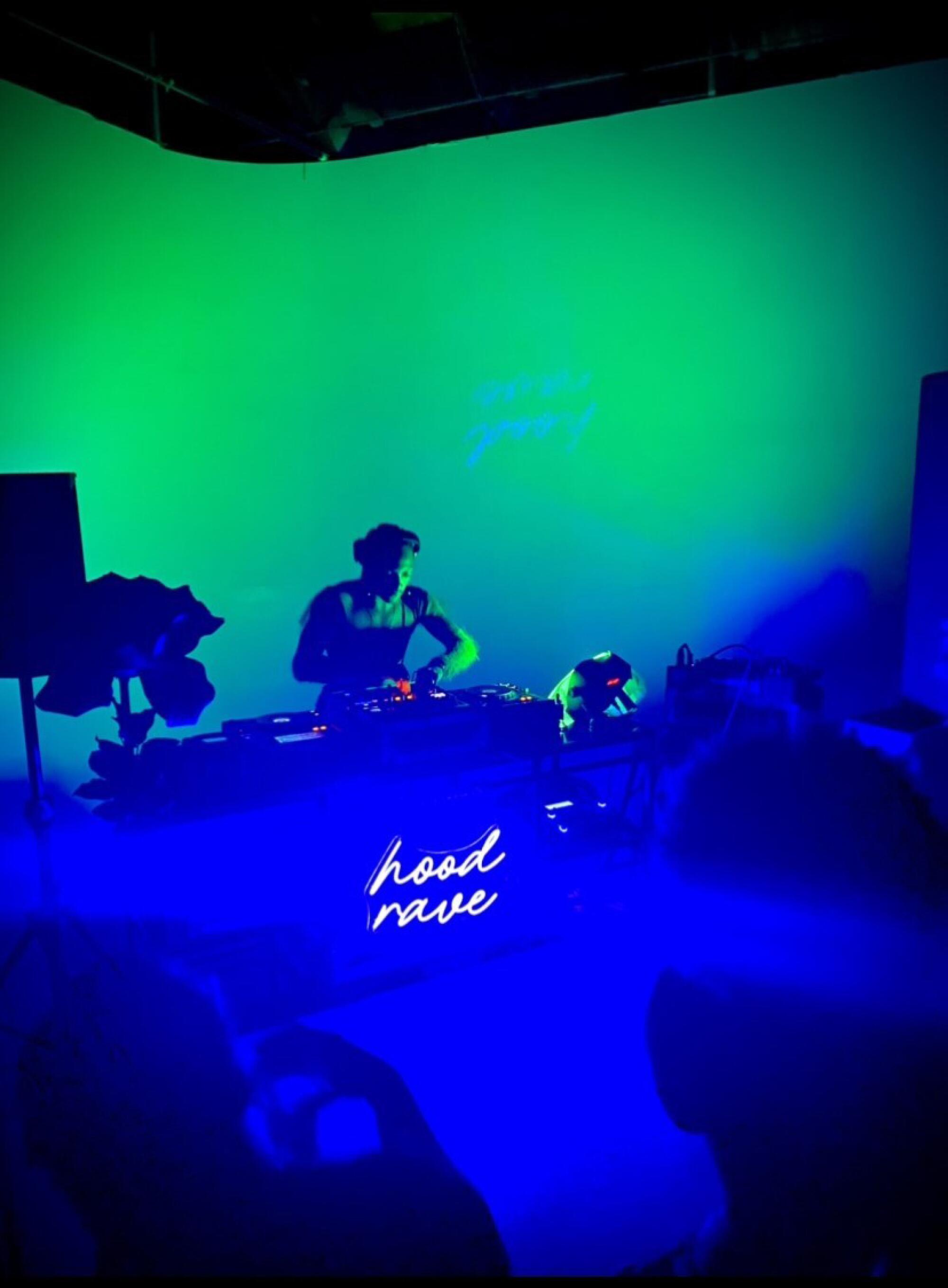- Share via

For Kumi James, a.k.a. BAE BAE, liberation happens on a dance floor. Not just any L.A. dance floor but one that lives underground, run by — and centered on — Black femmes and queer people. Hood Rave is the place where a DJ’s set can shift organically from a deep cut made by an Angolan immigrant in Portugal to a borderline-problematic-but-beloved Rick Ross song, to a warm, thumping house track from ’90s Chicago, and the crowd won’t skip a beat. Here, dancing feels not only freeing and joyful but deeply rooted in ancestry.
A multidisciplinary artist, music producer and filmmaker, James has been DJing around the world and throwing parties in L.A. for nearly a decade. The Arlington Heights native has consistently used their work as a means to uplift Black femmes and queer folks. Their Instagram archive, Negress, which takes its name from artist Kara Walker’s landmark work, is meant to draw attention to Black women and femme identity — “because it’s unique,” says James. They also have a monthly radio show on dublab by the same name that gives a platform to emerging DJs and artists, along with a monthly show on NTS called “Baexploitation.” “My practice is very communal,” they say. “It always has to do with other people and supporting their work as well. It’s not just me, ever. A lot of it is curatorial.”
James founded Hood Rave in 2020 and now collaborates on it with their close friend, Kita Clarke, a DJ from South Central. With Hood Rave, James and Clarke are building an alternative space — one that not only brings dance music and rave culture back to its Black roots but imagines a new future for Black dancers in L.A.’s underground. Ahead of Juneteenth, James spoke with Image about raving’s potential, and the spiritual transcendence that happens when you gather 500 Black people on a dance floor in South Central.
It’s a feeling when you’re with that many Black people. It has an energy on its own that’s spiritual and has the potential to be revolutionary.

Hood Rave is a party. But it’s also a political project — making space in the underground that centers Black femmes and Black queer people. We’re growing, but last time we had around 500 people and 75% were Black, which is pretty significant. Historically, there has always been a Black underground or Black club culture. We always needed space, but L.A. is challenging because Black people are policed when they’re in groups. We had to go underground.
Most of the DJs are Black femmes or queer folks. With just that alone, people wild out and dance so hard. It’s just one of the most beautiful things.
Two Black femmes run the party — me and my close friend Kita. Hood Rave symbolizes the relationship I have with her. Kita is the “Hood” of Hood Rave. She knows everything about underground and emerging hip-hop. Then I know all the rave genres, like drum and bass, techno, house — it’s really more expansive than that — but us coming together and bringing people to DJ who combine these things in a really experimental way, people lose their minds. They’ll hear a track they know, then it’s like totally inverted.
DJing at Hood Rave, I don’t have to coddle the audience or kiss their ass. Everything is already towards their tastes. I grew up in Arlington Heights on hip-hop and R&B. I bring in those musical influences and then mix that with club music and genres from around the world. And the dancers in the crowd are open to it. That makes me feel free.

There are other types of spaces which are more, say, heteronormative and Black, or commercial and Black, where maybe the values are different. At Hood Rave, we have clear values and we post them everywhere. This is a consent-centered space. I have a speech I give every time because I want people to know: Ask for consent. No harassment. No transphobia. There’s a list of things.
Having those values at the forefront of the space and all of these people who are mostly Black — it’s a clear, alternative type of world we’re trying to build where we’re really loving and respectful of one another, and not trying to intentionally harm each other. That’s a process. It’s not perfect. But the fact that those things are guiding the space and creating a culture in the space, I think that’s what makes it feel radical, liberating or free. Having that container allows everybody to wild out. It’s beautiful. I don’t always use the words “safe space” because we can’t guarantee that — but it’s a safer space.
The name was so significant because I’ve thrown parties for eight years or so, and I’d never really found the right name for what I was doing — which was normally aboveground, at bars and clubs. But we found we didn’t have as much control over the space. With Hood Rave, we hire everyone from top to bottom, and it’s pretty much all Black community or staff. We hire bartenders. We have safety monitoring. These are all our friends. We create this infrastructure. It goes up in one night and then comes down, but it really is another world, a whole other vision of what it could be.

I feel most liberated when I’m in community with other Black queer people and feel a sense of shared responsibility. I helped create this space, but other people in the space are looking after me. It’s an exchange: The care is going in both ways. When I’m dancing, it feels really freeing; it also feels ancestral — like we’re tapping into something deeply rooted.







